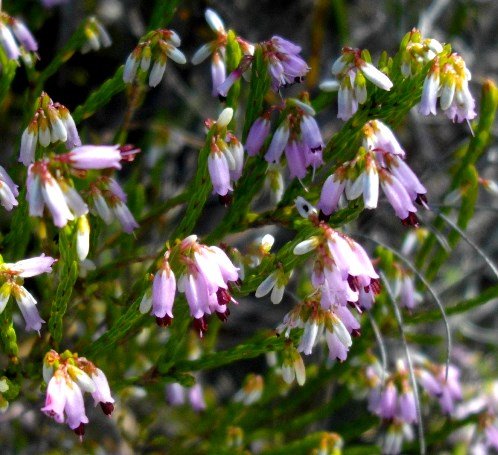Erica equisetifolia

Author: Ivan Lätti
Photographer: Thabo Maphisa
Erica equisetifolia, commonly the horsetail-leaved heath and previously Blaeria equisetifolia, is a compact, erect to rounded and hairless shrublet growing numerous whip-like branchlets and reaching heights from 20 cm to 30 cm. It forms part of the Pyronium Section of the Erica genus as E. parvula according to Baker and Oliver, minor heaths according to Manning and Helme.
The narrow or needle-like green leaves overlap in whorls of three, pressed upon the stems, their tips in-curving. The leaves vary in length on different plants. A slight, whitish line is sometimes visible on the back of the leaf where the down-curving leaf margins don’t quite meet. The specific name, equisetifolia, refers to the leaf-shape that resembles the tail of a horse. Equus means horse, saeta means bristle or thick animal hair (ironic in naming a hairless plant) and folium meaning leaf; all these words used in the description are Latin.
The small flowers are white or pink, somewhat tubular to slightly urn-shaped with short, broad lobes that curve slightly outwards. Short scale-like or needle-like bracts or bracteoles are present on the upper parts of the longish flower stalks, allowing the flowers to nod. The narrow, pointed sepals clasping the base of the corolla tube are pale to dark purplish, forming a short cup. Four blackish anthers are spurred at the base and protrude from the flower mouth. The nearly white stigma is exserted beyond the stamens, its stigma club-shaped. Flowering happens from before midspring to after mid-autumn.
The species distribution is in the Western Cape, mainly from Bain's Kloof to the Cape Peninsula and Bredasdorp.
The habitat is fynbos flats and mountain slopes. The habitat population is deemed of least concern early in the twenty first century (Manning and Helme, 2024; Manning, 2007; Bean and Johns, 2005; Bond and Goldblatt, 1984; Baker and Oliver, 1967; Andrew, 2017; iNaturalist; iSpot; http://redlist.sanbi.org).

